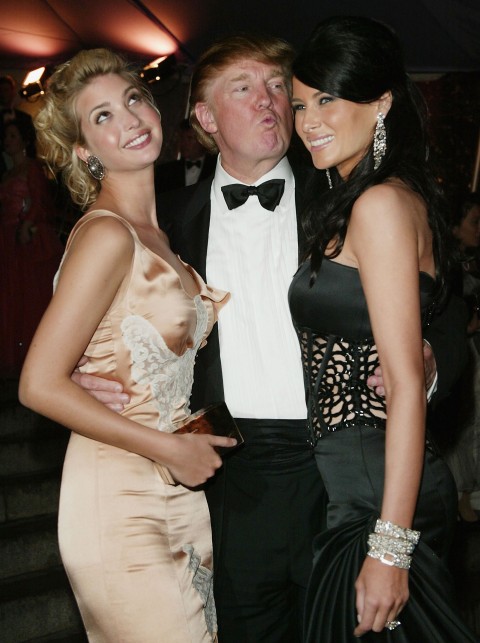
Trump’s first of two daughters Ivanka and third of three wives Melania. (Washington Post)
“I can do one of two things,” President Theodore Roosevelt snapped after being informed that his First Daughter, Alice, had yet again been seen in that embarrassingly vulgar act of cigarette smoking. “I can be President of the United States or I can control Alice. I cannot do both.”
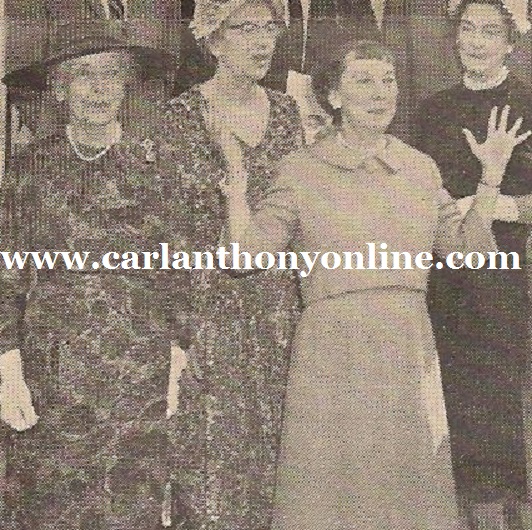
First Lady Mamie Eisenhower hosted a reunion of former First Daughters in 1959 – although she had none of her own. Behind her, left to right, Alice Roosevelt, Helene Taft and Marion Cleveland.
The nation seems poised on the precipice of an abyss, fearful of a new communist plot for world domination, the loss of universal health care and whether the incoming president’s daughter Ivanka will trump Melania, his wife, to become First Lady since Mrs. Trump isn’t going to Washington until, at earliest, June while Miss Trump is moving there next week.
Not since Dwight D. Eisenhower became president in 1953 has there been a President without a daughter and not since 1915, when widower Woodrow Wilson married a second time has there been a President without a wife. Yet in three earlier instances, there was no wife or daughter living in the White House – just a widower.
Martin Van Buren’s daughter-in-law Angelica didn’t serve as First Lady until after she married his son two years into his presidency. Chester Arthur’s sister Molly McElroy didn’t until a year and a half into his presidency.

An illustration imagining the 1805 Christmas Day of President Jefferson, fiddling to his grandchildren s his daughter Martha Randolph prepares table.
Contrary to the persistent myth, Thomas Jefferson’s daughter Martha Randolph never served as his White House hostess. During his eight year presidency, she made only two lengthy visits as his guest, although she received guests and visitors with him.
In modern memory, there’s always just been Her, the president’s wife. Components of what, in fact, a “First Lady” really does, however, has led to a surprisingly wide variety of scenarios depending on the particular presidency and the women involved.
The media and the citizens fixate on the clothes and dishes stuff. Fewer, regretfully, actually examine the public service, policy and lobbying they’ve done on behalf of largely neglected constituencies.
All of that is just the iceberg above water.
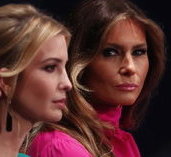
Wife and daughter. (NYT)
It is the submerged mass below the surface, too murky for the public to truly discern, where the most important work is done by only those who intimately know the emotional landscape of the President. Insisting on a schedule optimized to a President’s best time of the day, when to make a President face the truth, how to tell the President what he doesn’t want to hear, when to provide support, confront a pending decision, offer unsolicited advice. When to call a President out with a screaming fight and get him to listen.
Depending on the President, sometimes two people doing this is better than one.

Wife and daughter during the campaign.
How the Trump women hammer out who does what is likely to remain between them. The father-husband may spectacularly bloviate on whatever crosses his mind, but what his wife and daughter determine as the best realm for themselves and how to carry it out will be privately determined by the more subdued duo.

Melania Trump.
Throughout presidential history it’s been mostly a wife who did it all.
When that wasn’t the case, however, the leading female role at the White House has been a matter of sharing, swapping, supporting, substituting and shadowing, occasionally by a random niece or sister, but otherwise always by a daughter.
Sometimes it was relief for the wife. Sometimes it created more trouble. Most got along. Some didn’t.
SUBSTITUTIONS PERMITTED

The fact that Melania Trump is staying home for awhile, as her stepdaughter Ivanka Trump moves close to her father in Washington is likely to only signal the latter will substitute on occasion for the former. Or it may well mean that even after Mrs. Trump arrives that Miss Trump will continue on with those First Lady tasks she likes. There have been only three times when a president’s wife was alive who chose not to assume any of the public roles of First Lady. Two lived in the White House, one tried but didn’t make it in time.

Anna Harrison was the first First Lady who didn’t live in the White House.
Anna Harrison arranged for what might be characterized as a time-released swap with her daughter Anna Harrison Taylor, and daughter-in-law Jane Harrison who both attended President William Henry Harrison’s 1841 inaugural and lived in the White House with him for his one-month presidency.
Having suffered a serious illness during the campaign, the family agreed that it would be best for the president-elect’s wife to make the arduous trip from Ohio to Washington, D.C. in the springtime, when there was less chance of an overturned stagecoach on the muddy turreted turnpikes that would carry her to Washington.
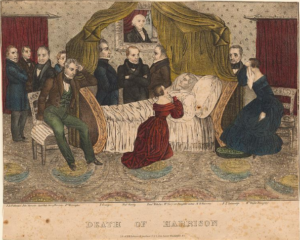
An engraver optimistically assumed that Anna Harrison (in red) had arrived in Washington in time to join her daughter Anna Taylor (in blue) at the 1841 deathbed of the President.
In the meantime, her daughter Anna would have to work out with her daughter-in-law Jane who did what in running the presidential household. Neither had much time to do anything, given the new President’s death to pneumonia.
Eliza Johnson, with her recurrent tuberculosis, proved to be her husband’s rock during his impeachment trial, choosing a sitting room with a door she kept open directly across the hall from the President’s office, his door also open, and listening closely to what transpired in his meetings, while she sewed. Only she dared to snap at him when his thin-skinned temper flared and he started cursing his enemies.

Eliza Johnson and Martha Patterson.
Meanwhile, First Daughter Martha Patterson managed all the social events, conducted a refurnishing of the state rooms on a shoestring budget, and offered conviviality to even those seeking to remove her father from office.
Presidential wife Peggy Taylor had spent most of her married life as a transient, moving from army forts in the wilderness to the swamps. She spoke publicly against her husband seeking the presidency in 1848, correctly predicting it would kill him. She would come to the inaugural, and move into the mansion but she refused to make any of the public appearances already expected of “mistress of the White House,” deftly managing her invisibility.

Composite image of Peggy Taylor and Betty Bliss.
Having refused to sit for a studio daguerreotype that would inevitably find its way into the hands of illustrators, outside of her family, the staff and a handful of political leaders, nobody knew what she looked like. Her sitting room in the private quarters was the heart of her extensive southern clan’s social life. At private functions she hosted upstairs where other political figures were in attendance, Mrs. Taylor never failed to proudly point out her husband’s achievements.
Downstairs it was her vivacious, spirited daughter Betty Bliss who appeared on her father’s arm at public receptions and formal dinners. A newlywed, her husband worked as the President’s private secretary and at 21 years old, she was the youngest woman to perform as public hostess. What the public didn’t always realize was that the president’s wife was often in attendance at these events. Nobody knew it was her because nobody knew what she looked like.
CO-HOSTESSES & SURROGATES

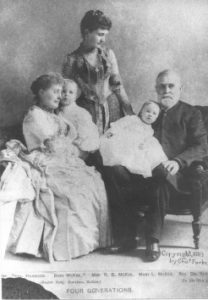
First Lady Caroline Harrison holds her grandson, First Daughter Mary McKee stands; a granddaughter sits with the First Lady’s father.
Most First Daughters who substituted as First Ladies did so for brief periods of time or limited their effort to only particular roles. There were also a number of them who acted as co-hostesses at the larger reception-line events.
Presidential wife Caroline Harrison was a capable hostess and housekeeper all on her own. She also had a lot of other commitments, including lobbying Congress for a massive rebuilding of the White House (which never passed), and serving as the first president-general of the newly-created DAR, then a national feminist patriotic organization.
Her married daughter Mary McKee was in residence with her husband and two children and was able to substitute for her mother at small events or receive guests and callers. On numerous occasions, she also received guests alongside her mother. She never assumed all of the First Lady’s roles until her mother’s death to cancer just weeks before her father lost his bid for re-election in the 1892 election.
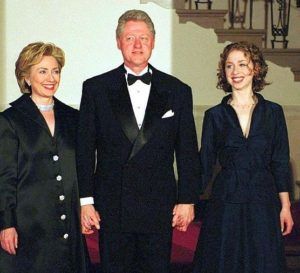
Chelsea Clinton appeared as a cohost with her parents at the White House Millennium New Year’s Eve Party, 1999.
By the end of her father’s eight-year presidency, daughter Chelsea Clinton frequently joined her parents at large social events, notably the Millennium New Year’s Eve celebration and during Hillary Clinton‘s 2000 campaign for the United States Senate, joined her father on a state visit to Australia.
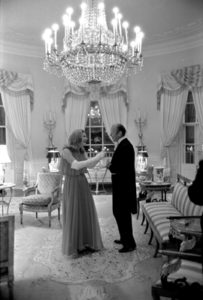
Susan Ford with her father before the state dinner at which she substituted as First Lady for her convalescing mother.
Only on one occasion did First Daughter Susan Ford substitute as First Lady, a formal state dinner held in October of 1974, at the time her mother Betty Ford was recovering from a mastectomy.
More often, adult presidential daughters, married or single, living in or out of the White House, were a presence at public events alongside their mother, but rarely took center stage. Abigail Fillmore and her daughter Abby Fillmore made an especially unique duo. At private receptions, the First Lady played the piano while the First Daughter played the harp as after-dinner entertainment for guests.

The Obama First Daughters, rather than the First Lady, traditionally joined the President in the annual Thanksgiving pardoning of the presidential turkey.
The twin daughters of Laura Bush assumed more of a public role during their father’s 2004 reelection campaign, joining their mother to speak at the national convention that renominated him and making some campaign appearances. They also joined their mother on a visit to African nations in spearheading the administration’s AIDS eradication initiative, Jenna Bush going on to author the book Ana’s Story, based on the experience.
Malia Obama or Sasha Obama appeared in the shadow of their mother Michelle Obama, both daughters maintained two annual holiday traditions, publicly appearing with the President in accepting the live turkey presented to the White House before Thanksgiving, and joining the First Lady in accepting the Christmas tree, and hosting the Easter Egg Roll. Here they are with the President at his last Thanksgiving turkey pardon ceremony:
FIRST DAUGHTERS & STEPMOTHERS

If a rivalry between Melania Trump and her stepdaughter seems an inevitable invention among social media gossip, it would only be the high-tech version of an old White House story about First Daughters and the stepmothers who replaced their own mothers.
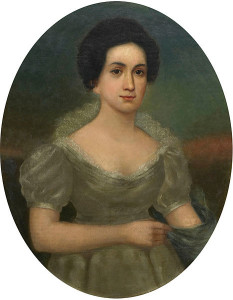
Invalid First Lady Letitia, the first Mrs. John Tyler.
While presidential wife Letitia Tyler was able to direct the presidential household from her upstairs bedroom, she was physically unable to act as public hostess due to paralysis from a stroke.
There were four daughters: Mary was married and lived in Virginia, Lizzie would soon marry and move, Alice was not yet a teenager. Letty Semple, was estranged from her husband and had come home to live with her parents.
The President passed over Letty to instead designate his daughter-in-law Priscilla, a former actress as official hostess. Whether or not it was due to her ambivalent marital status, it was a slight left unmentioned. Like many a presidential daughter, Letty Semple loyally, madly adored her father and did not believe he could do any wrong.
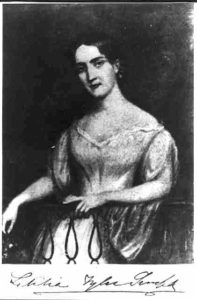
Letitia Tyler Semple.
Letty’s mother died in September of 1842 and her brother and sister-in-law moved from the White House in March of 1844. As the last adult woman living with the President, Mrs. Semple could finally be her father’s sole feminine companion and a happy southern belle presiding over his presidency.
For three months.
Among the seven Tyler children, none were more numb with enraged shock than Letty when it was learned that their father had eloped with a girl who was only one year and one week older than herself.
Adding insult to injury, Julia Tyler was a Yankee from New York. If Letty Semple was miserable before, she became forever embittered.
Unlike her siblings, she refused to show her new stepmother even the most basic civility.
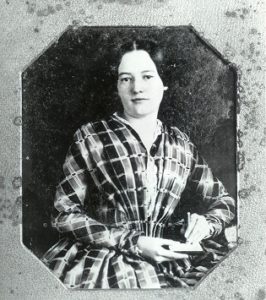
Julia Gardiner Tyler, in the first photograph ever taken of an incumbent First Lady.
She would not live under the same roof with her father’s new wife and vacated the White House alone while her father enjoyed his honeymoon. Later, when she learned that her stepmother had granted her estranged husband’s request of a loan, she wrote him there could never be a reconciliation and consider them to be divorced.
It can easily be speculated it was a matter of displaced anger at her father. It can also be easily speculated that John Tyler had a good reason for making his daughter-in-law hostess, and not his daughter.
There was no overt hostility between presidential wife Edith Roosevelt and Alice Roosevelt, the daughter of Theodore Roosevelt by his first wife who died in a matter of hours after giving birth to her.
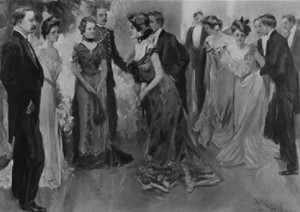
Alice Roosevelt receives guests while standing between her father and stepmother.
Still, there was tension between Edith and Alice. Like the Tyler case may well have been a matter of displaced anger that would have been more healthily directed at her father; not once did the President ever mention, even acknowledge the obvious existence of Alice’s birth mother to her. It was all very Victorian elite stuffed emotions.
As the most important component of her First Lady role, Mrs. Roosevelt dictated every detail about the First Family, from responding to public mail about the education of her four sons to the poses they would strike for a series of seemingly intimate photo portraits to be distributed to the press.

The Roosevelt-Longworth wedding, Alice between her husband and father.
Her stepdaughter Alice, however, she could not control. The sixteen year old First Daughter refused to accept religious training or attend formal schools. She would not arrive in Washington from partying up the eastern seaboard on the days and times she promised she would.
When finally Alice married Congressman Nicholas Longworth in a grand 1906 White House wedding, Edith turned to her and sniped, “I want you to know I’m glad to see you leave. You have never been anything but trouble.”
Some speculate that the increasing presence at the White House of the president’s daughter Maureen Reagan created discomfort for the president’s wife Nancy Reagan.
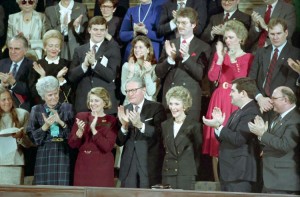
Maureen Reagan in red, stands behind stepmother Nancy as she gets a standing ovation during the President’s 1988 State of the Union speech.
The issue was never friction between them but the fact that the daughter was also still strongly bound to her own mother, who happened to be the President’s divorced ex-wife, actress Jane Wyman.
After her father interceded to get her the job of co-chair of the National Republican Committee, however, Maureen Reagan was a greater presence in the White House, staying in the Lincoln Suite and attending any state dinners whenever in residence.
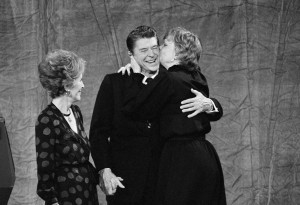
Maureen Reagan, right, kissing her father on the night he won the presidency; Nancy looks on.
Breezy but bold, Maureen Reagan avoided any potential strain and forged a strong relationship with her stepmother, referring to Wyman as “mother” and the President and First Lady as “the folks.”
Although permitted to host private gatherings and hold meetings in the White House, she was never asked to substitute for the First Lady or make appearances on her behalf.
Margaret Wilson was the only one of Ellen Wilson‘s daughters who remained unmarried.
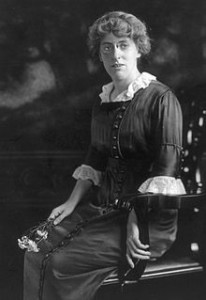
Margaret Wilson.
Engaging, witty and compassionate, she was a bright social aide to her mother, who had little interest in that aspect of the First Lady role. When Mrs. Wilson died in August of 1914, Miss Wilson assumed the primary roles while a cousin helped.
When the widowed President began to secretly date Edith Galt, they used Margaret as their beard, but after the marriage the new First Lady staked the family quarters as her roost. Suddenly Margaret was spending more time in New York on voice lessons
When the Wilsons went to Europe after World War I, Edith didn’t mind Margaret leading the march through the mud to meet the doughboys and do all the speaking at charitable events but when it came time to greeting royalty, there was only room for one lead Wilson woman. It wasn’t the First Daughter. Here is Margaret Wilson with General Pershing visiting American troops stationed in France. This clip is silent:
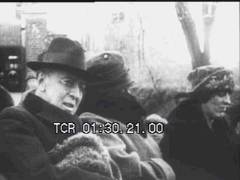
Woodrow Wilson with Edith (center) and Margaret Wilson. (Movietone newsreel image capture)
When the President suffered a massive stroke, the First Lady refused everyone access to him except herself and the doctor. Margaret had to first gain her stepmother’s approval to see him, on the promise that she was speak of it to nobody.
And after Wilson’s death, as Margaret Wilson struggled financially, she made the deadly mistake of having others ask Edith, who controlled the estate, for a small loan. It was denied. Margaret moved to an ashram in India and never saw Edith again.
There were, of course, times when even their own mothers rather wished there were no First Daughters around.
POLICY & POLITICS
Ivanka Trump has suggested that her personal interest in finding a balance between work and family obligations of women, and a curiosity in climate control would become public issues she’d give focus in her father’s presidency. She has also shown herself to be a gatekeeper and advisor to him.
Among the roles of a First Lady that has always proven to be the most potentially controversial has been their involvement in politics, policy and the administration of the presidency. In several instances, First Daughters were compelled enough to assume that role and sometimes with consequences.
Abrasive Eliza Hay served seemingly as an equal to her mother Elizabeth Monroe, who suffered from seizure disorder, a fact unknown to the public. Mrs Monroe appeared at receptions and dinners as the presidential consort but it was Mrs. Hay who seemed to have determined the social and household decisions.
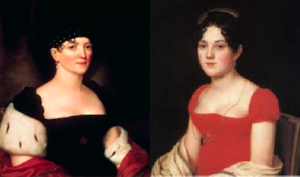
First Lady Elizabeth Monroe, First Daughter Eliza Hay.
Unfortunately for the First Lady, the First Daughter’s decisions offended nearly universally the Cabinet, Supreme Court and the Congress who assumed that a social call made by their wives to the White House would be returned. When her younger sister Maria was married in the executive mansion, Eliza let the diplomatic corps know they might as well save their flattering good wishes and gifts. They would not be acknowledged, let alone lead to an invitation. Such overt snobbery nearly took on international consequences after the foreign representatives voiced their anger to the Secretary of State.

Anna Roosevelt with her daughter and her mother’s dog, helped host events like the 1933 Easter Egg Roll.
It may well be that Mrs. Hay was simply seeking to protect her mother’s secret and preserve her fragile health, but even when a kind person asked how her husband was doing, the First Daughter snapped back sarcastically “He’s dead and I’ll hear nothing more about it.” Her legendary rudeness, however, gets lost in the shorthand sauce of history while almost always her mother gets the blame.
First Daughter Anna Roosevelt lived in the White House at both the beginning and the end of her father’s presidency, but played different roles each time. In the beginning, she moved in with her parents, taking along her two small children. She was often her mother Eleanor Roosevelt‘s companion, helping to co-host especially large events like the Easter Egg Roll and generating some criticism for seeming to profit off the presidency, by authoring a children’s book about “Scamper,” a rabbit’s life in the White House.
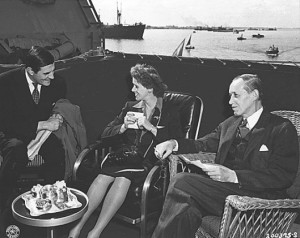
Anna Roosevelt in 1945 seated between the British Ambassador and FDR advisor Harry Hopkins during the Yalta Conference, to which she accompanied her father as aide, and met Stalin.
At the end of her term, Anna Roosevelt essentially became the private First Lady to her father.
Then intent on the U.S. winning World War II, the President withdrew more into a circle of friends who offered light conversation and relaxation, a scenario which did not include his wife who insisted on raising important issues with him.
He soon made Anna his confidante, choosing her to accompany him to the Yalta Conference where he met with Winston Churchill and Josef Stalin instead of asking Eleanor. He not only shared his assessments of his daily talks, but while there she served as his hostess and met with Saudi and Ethiopian leaders. Here is a newsreel showing her on the navy cruiser they used near the Suez Canal:
In the last months of the President’s life, it was Anna Roosevelt who managed it for him. At his request, she even arranged for clandestine meetings with his former mistress Lucy Mercer. After his death, Mrs. Roosevelt learned this and it created an understandable rift with her daughter for a period of time.
As her mother Nellie Taft recovered from a stroke suffered in her second month as First Lady, Helene Taft took a leave of absence from Bryn Mawr to serve as her substitute, sharing the duties with three of her maternal aunts as well.
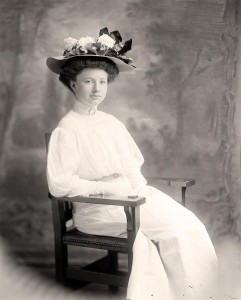
Helene Taft.
After the horrific deaths of immigrant girls trapped in the fire at New York’s Triangle Shirtwaist Factory, the First Daughter joined a public march and rally calling for stringent health and safety measures in factories.
She delicately raised the subject with her father, knowing her mother had already begun just such an effort, to establish such standards in the federal workplace.
In his last year as President, Taft agreed with the reform and signed it into legislation by executive order.
Influenced by her mother’s commitment to improving the housing conditions of the capital’s impoverished and largely African-American population living in alley dwellings around the U.S. Capitol Building, Margaret Wilson led a local public movement to give residents the right to assemble in municipal buildings and organize as a community.
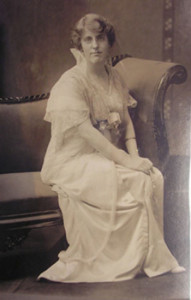
Margaret Wilson.
Some of what she urged, however, came close to openly defying her father’s support of racial segregation in the city.
Not unlike Ivanka Trump, Margaret Wilson had a bit of her own brand and sold products. In her case it was her voice and she sang the Star Spangled Banner for a record album that was sold to the public at the 1915 Pan-American Exposition, the entire proceeds from which were donated to the Red Cross. No controversy ensued.
Except perhaps the value of the singing voice.
Here’s First Daughter Margaret Wilson singing the national anthem on her record:
Other First Daughters involved themselves not in the strategy of Administration policy but politics.
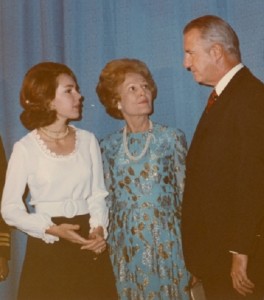
Pat Nixon was often joined by her daughter Julie at many campaign and poltiical events, seen here with Vice President Spiro Agnew.
First Lady Pat Nixon wearied of the media pressure as the Watergate scandal worsened and became increasingly inaccessible to the press corps by the spring of 1974. In contrast First Daughter Julie Nixon Eisenhower was so dogged in her loyalty of the President that she determined that she would grant a request by the White House press corps to have questions answered about the personal pressures the scandal was creating for the family.
Despite the emotional sensitivity involved, she met the reporters in the Rose Garden for an open press conference, handling unfiltered and confrontational questioning, never losing her rationality, managing to defend her father without becoming defensive.
Julie also appeared with her mother at some social events, and took an active role in her father’s two presidential campaigns. Behind the scenes, she was as equally penetrating in her questions to the President on public events, his speeches, media reactions and strategy, some of which was preserved among Nixon’s taped telephone calls. In the beginning of his second term, Julie Nixon assumed more of an overt public role as an Administration representative, with especial focus on environmental issues. Here she is meeting with the President in his office:
An unabashed feminist, Maureen Reagan was persistent in getting her father to not just acknowledge the national Republican party’s failure to cultivate and reward the capabilities and accomplishments of its women’s committees and workers but to take action in demanding more be appointed to higher ranking positions of power. In his re-election campaign year, she hit the media trail defending the Administration, armed with an expert recall of facts and statistics:
MEDIA CELEBRITIES
Without question, Melania Trump has been far less accessible as a public speaker and media celebrity than does Ivanka Trump. This too has historical precedence. There were just several First Daughters who, despite never acting as First Ladies themselves, garnered so much national fame that their profiles largely eclipsed those of their mothers, including two who despised personal media coverage.
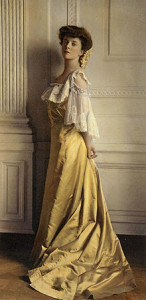
Alice Roosevelt.
Alice Roosevelt is the George Washington of First Daughters.
In fact, in early 1902, after this First Daughter rather than the First Lady was given the honor of christening the yacht Meteor alongside its owner, German Prince Henry, the press dubbed her “Princess Alice.”
It was her less graceful antics, however, that captured the interest of the nation, from keeping a pet snake in her purse, to dancing on top of cars, to betting at the racetrack.
If it was all a public call for her father’s attention, it didn’t work. In reaction, he sent Princess Alice on a junket to Asia where she was treated as American royalty in Japan, China, Korea and the Philippines. While on the voyage she jumped into the ship’s pool fully dressed.
By the time she returned, this most famous First Daughter not only graced the cover of national magazines but had a song, Alice Blue Gown, named in her honor.
Alice remained a celebrity for decades after. She later recounted a telling anecdote about her acting out at her father’s inauguration – but she was just doing what he did:
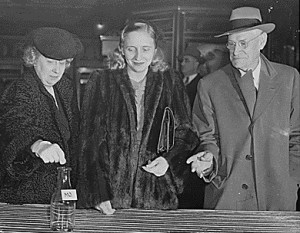
Bess Truman, at a March of Dimes photo op, always felt more comfortable in the public eye if her daughter Margaret joined her.
Bess Truman not only dreaded living an existence that the public assumed it had a right to know everything about, but having dozens of flashbulbs popping in her face, personal questions shouted at her and moving stupidly for the newsreel cameras. She developed genuine anxiety about being on public display and having to face thousands of strangers at massive receptions. But she didn’t take medication – she took her daughter.
Bess snapped that Margaret Truman was “a ham,” but if she used this to her own advantage. her daughter then used that to her advantage.

Margaret Truman enjoyed media exposure and often substituted for her mother in fulfilling public service media events.
Almost every large event where Mrs. Truman agreed to headline outside of the White House, she took her daughter as escort.
If Margaret was home from her college classes at nearby George Washington University, she would be corralled by her mother into the receiving line.
Bess Truman never gave interviews, but made Margaret speak for the family. And she loved doing it.
The First Daughter not only held press conferences, but pursued an even bigger public career as first an opera singer, then a “television personality,” and author. Here is one of her press conferences:
Well past the death of her parents, she was still churning out books on both of them, and then their peers.
Substituting for CBS newsman Ed Murrow on his show Person to Person, Margaret Truman managed to score what no other journalist ever could: Bess Truman’s only television interview:
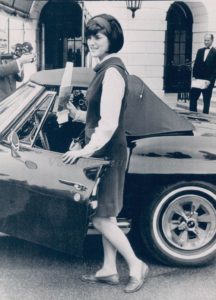
Luci Baines Johnson about to drive off from the White House in her Stingray for her first day of nursing school at Georgetown University.
Certainly, the media persona of Luci Baines Johnson as a typical pre-Woodstock Sixties teenager who got a Sting-Ray car, changed her first name to end in a cuter “i” than its original “y,” went crazy for the Beatles and had a bride’s dream wedding was a more colorful narrative than the one crafted about her diligent but circumspect mother Lady Bird Johnson or her bespectacled sister Lynda Bird Johnson, dubbed “the serious one.”
Later recalling her father’s salty mantra that it was better to have people “on the inside of the tent pissing out than on the outside of the tent pissing in,” the President sent sixteen year old Luci out on the 1964 campaign trail to headline youth voter events, despite the fact that she herself was too young to cast her own ballot.
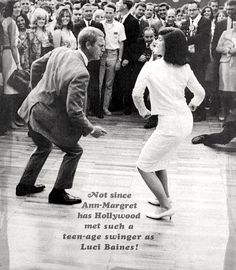
When Luci Johnson danced the Watusi, she was thrust into the realm of movie star supermarket tabloids.
That was where the irrepressible First Daughter made even bigger headlines by busting the right moves with actor Steve McQueen of the dance known as the “Watusi.”
In that one moment, her star rose into the realm of political celebrity, eclipsing that of the First Lady. Suddenly, she replaced the widowed Jackie Kennedy as the weekly fodder for supermarket movie star magazines.
For the first time since the song Alice Blue Gown about her elderly mentor, there was a dance named for a First Daughter, Watusi for Luci.
Here is footage of her making presidential dance history, along with the song immortalizing that moment:
Miss Johnson never substituted for her mother, but she did host several White House receptions and events on her own, including a Christmas party for local children who were without families of their own.
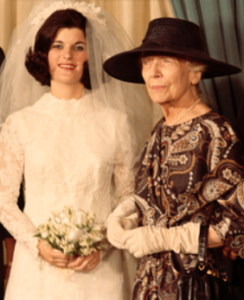
The elderly Alice Roosevelt at the White House wedding of her spiritual First Daughter successor Luci Johnson.
She also fulfilled that unseen role of being a necessary confidante and emotional support to the President. Having converted to Catholicism, she’d come to know some nearby priests and friars. During especially anguished moments of the escalating Vietnam War, LBJ asked his daughter to take him to pray with them in the seclusion of the monastery.
With her sense of mirth and irony, respect for history, open-heartedness and enthusiasm, Luci Baines Johnson was a breath of fresh air, a natural national celebrity and the closest the nation came to having another Alice Roosevelt.
It may well be that Ivanka Trump proves to be more like Alice Roosevelt’s father. “I can do one of two things,” Ivanka Trump might well be mused to soon fume. “I can be First Daughter or I can control my father. I cannot do both.”
Categories: First Daughters, First Families, The Trumps
Tags: Alice Roosevelt, Anna Roosevelt, Eleanor Roosevelt, Ivanka Trump, Margaret Wilson, Melania Trump
 Jackie & The Nixons: Mrs. Kennedy Returns to the White House, With New Images of the Visit
Jackie & The Nixons: Mrs. Kennedy Returns to the White House, With New Images of the Visit  The President as King: A Political Cartoon History
The President as King: A Political Cartoon History  The First White House Valentine’s Day Dance: the McKinleys, Ragtime, Racism & The Romance of the “Ghost Girls”
The First White House Valentine’s Day Dance: the McKinleys, Ragtime, Racism & The Romance of the “Ghost Girls”  Liz Taylor Meets Jackie Kennedy: Tabloid Fantasy to Chance Encounter & The Only Photos of Them Together, Part I
Liz Taylor Meets Jackie Kennedy: Tabloid Fantasy to Chance Encounter & The Only Photos of Them Together, Part I  Liz Taylor Meets Jackie Kennedy: Tabloid Fantasy to Chance Encounter & The Only Photos of Them Together, Part II
Liz Taylor Meets Jackie Kennedy: Tabloid Fantasy to Chance Encounter & The Only Photos of Them Together, Part II  Melania Trump v. John Kelly: First Ladies & West Wing Personnel, A Brief History
Melania Trump v. John Kelly: First Ladies & West Wing Personnel, A Brief History
Leave a Reply